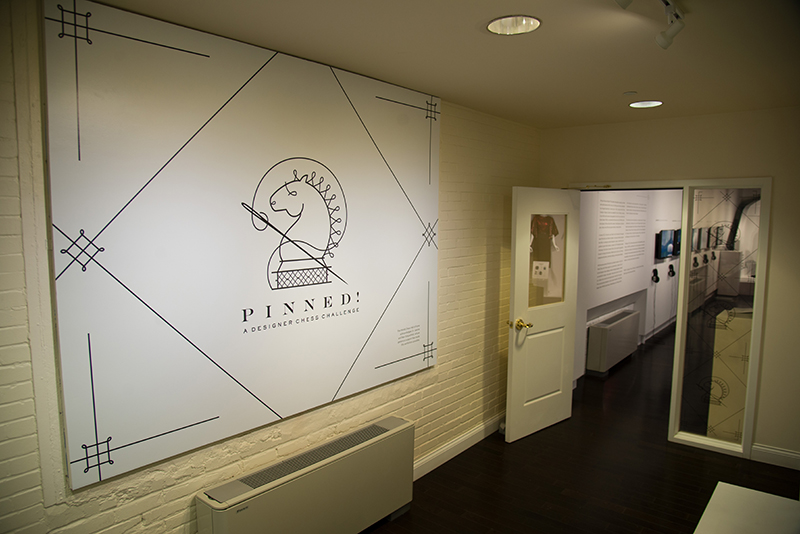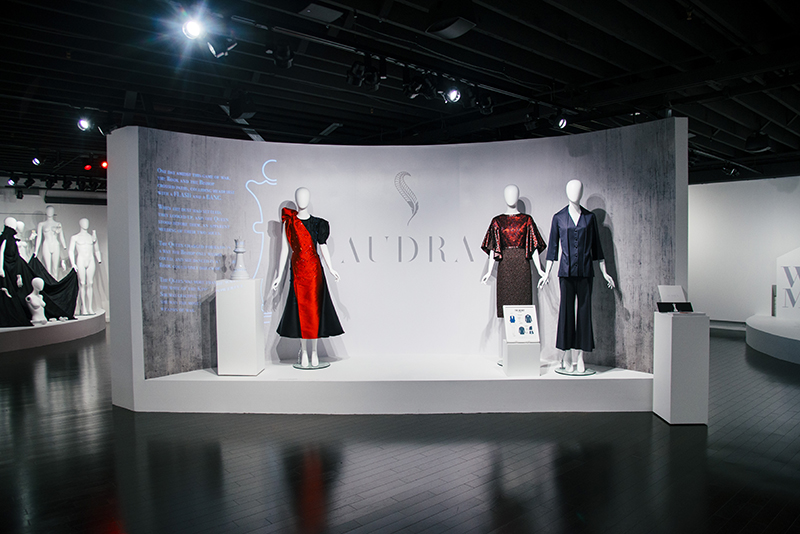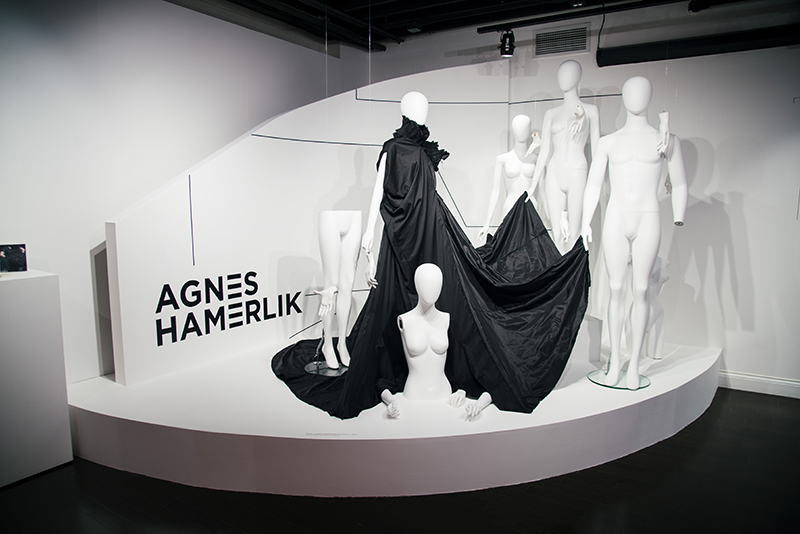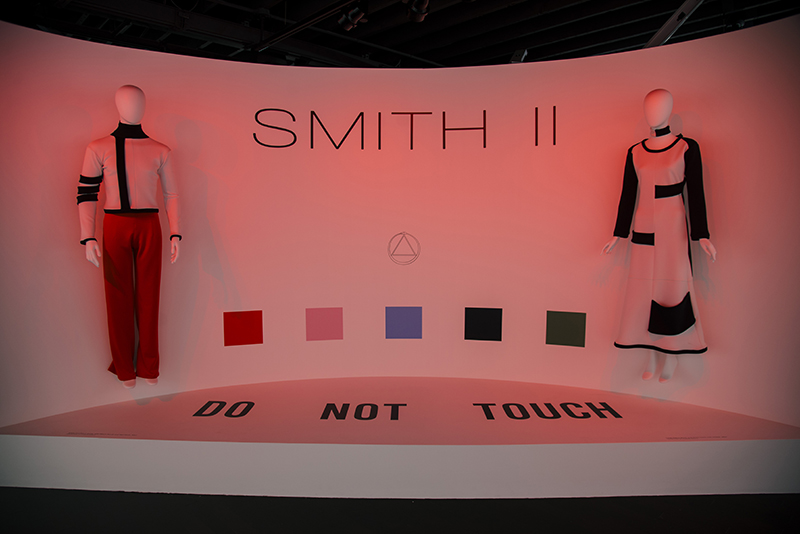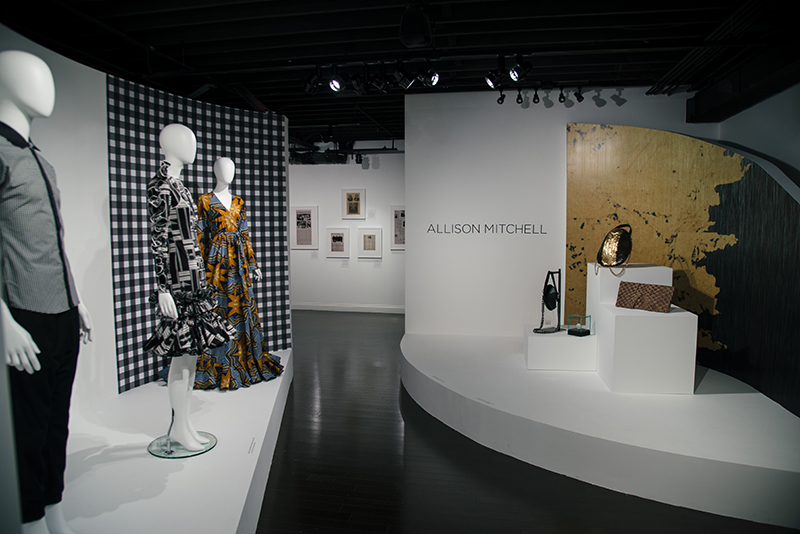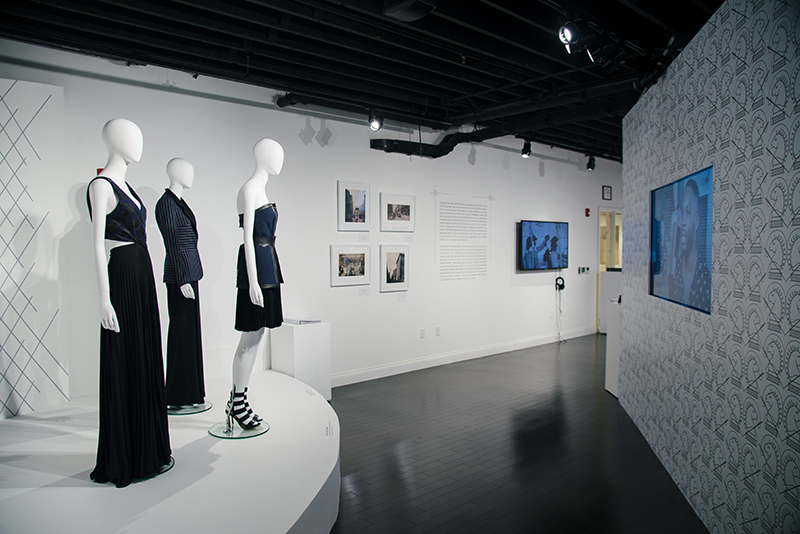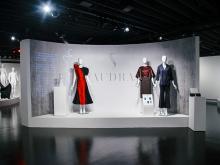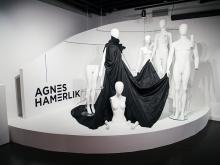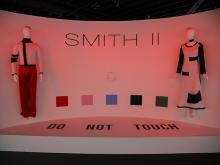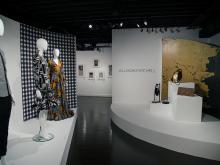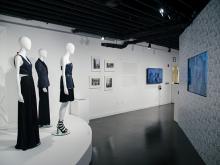PINNED! is a first-of-its-kind designer challenge, developed in partnership with the World Chess Hall of Fame and the Saint Louis Fashion Fund, to celebrate the intersection of chess and fashion.
On view: October 6, 2017 - March 25, 2018
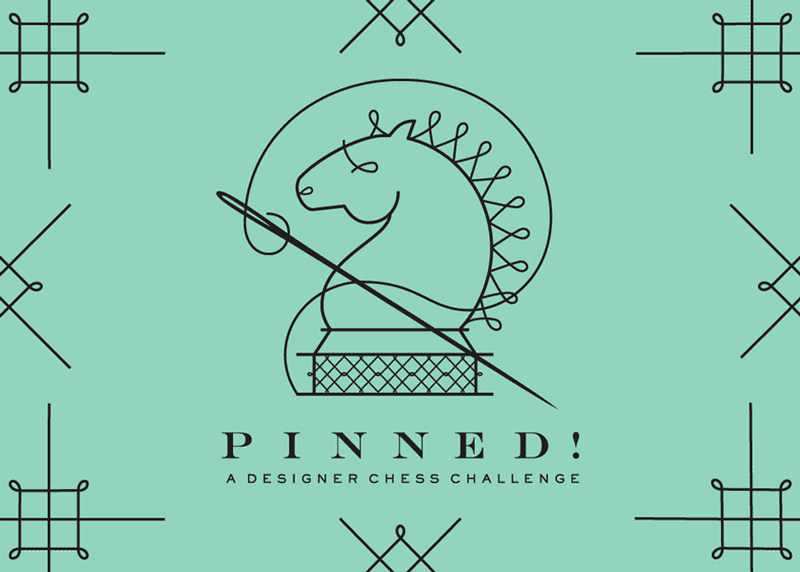
Paired with a consulting Grandmaster, each member of the Saint Louis Fashion Incubator's inaugural class is designing a chess ensemble for today’s chess player, in competition to win a $10,000 scholarship prize.
- Audra Noyes & GM Maurice Ashley
- Charles Smith II & GM Cristian Chirila
- Agnes Hamerlik & GM Alejandro Ramirez
- Allison Mitchell & GM Fabiano Caruana
- Emily Brady Koplar & WGM Jennifer Shahade
- Reuben Reuel & IM Nazi Paikidze-Barnes
With a mission to celebrate the game of chess and its significant impact on global culture, the World Chess Hall of Fame strives to partner with notable artists, historians, and institutions. Though we have been fortunate to collaborate with remarkable colleagues both nationally and internationally, for our latest exhibition, PINNED! A Designer Chess Challenge we had to look no further than downtown Saint Louis to the newly founded Saint Louis Fashion Fund.
Why pair chess and fashion? The modern chess player is young, hip, creative, and sophisticated and their choice of clothing worn during competition has changed drastically in recent years. In fact, reigning World Chess Champion Magnus Carlsen has modeled for Dutch clothing company, G-Star RAW and has been photographed in the front row at New York Fashion Week. While it is estimated that there are over 600 million active chess players in the world, and the number of rated players continues to grow, chess is one of the only sports without a formal uniform.
While chess seems to have exploded in Saint Louis since the opening of the Chess Club and Scholastic Center of Saint Louis in 2008, and the relocation of the World Chess Hall of Fame in 2011, the city has a lengthy chess heritage that dates back to the 19th century. Significant markers of its legacy include being the host in 1886 to a segment of the first World Chess Championship and in 1904 (the same year as the World’s Fair) both the Seventh Annual American Chess Congress and the Western Chess Association Championship. Today, Saint Louis is well-known as a chess center nationally and internationally, and was named the national chess capital by the U.S. Senate in 2014. Since 2008, the Chess Club and Scholastic Center of Saint Louis has hosted tournaments including the U.S. Chess Championship, U.S. Women’s Chess Championship, U.S. Junior Championship, U.S. Junior Girls’ Championship, along with the Sinquefield Cup and the Saint Louis Rapid & Blitz, two tournaments that have drawn the best players from the international community.
Fashion has had a similar history to chess in our city—as Saint Louis was once the second largest fashion hub in the United States. Between 1899 and 1901, the area along Washington Avenue beginning with the Eads Bridge was known as the Garment District. During this time Washington Avenue was able to claim more shoe manufacturers than any other street in the world, becoming known as “Shoe Street, U.S.A.” While shoes were the focal point of Saint Louis’ industry, other specialty items like hats and juniors clothes were also large parts of the production. For over 30 years, the area remained a center of fashion. Unfortunately, it began to decline in the 1930s with the Great Depression and industrialization. Until recently the end of Saint Louis’ Garment District was thought to be marked by the end of the Second World War; however, thanks to the Saint Louis Fashion Fund, the Garment District is being brought back to life.
In January 2017, the Saint Louis Fashion Fund introduced its inaugural class of the Saint Louis Fashion Incubator—a two year, intensive program which offers six emerging national designers a space, mentorship, and guidance to grow their businesses. Located at 1533 Washington Avenue in the heart of the former Garment District, the non-profit organization focuses on bringing the business of fashion back to Saint Louis through entrepreneurship-driven, community-building, and educational initiatives.
With the announcement of the Saint Louis Fashion Incubator in 2016, the World Chess Hall of Fame sought out a partnership to create a first-of-its-kind designer chess challenge wherein six emerging designers created a chess ensemble for today’s chess player—one practical piece to be worn by a player and a second avant-garde piece inspired by the game. Each designer was also paired with a “chess advisor” including Grandmasters Maurice Ashley, Fabiano Caruana, Cristian Chirila, and Alejandro Ramirez; International Master Nazi Paikidze-Barnes; and Woman Grandmaster Jennifer Shahade.
The six participating designers included Agnes Hamerlik of Chicago, IL; Emily Brady Koplar of Saint Louis, MO; Allison Mitchell of Dallas, TX; Audra Noyes of New York, NY/Saint Louis, MO.; Reuben Reuel of Brooklyn, NY; and Charles Smith II of Dallas, TX. The submissions were evaluated by an esteemed panel of industry professionals, including Saint Louis Post-Dispatch Retail Columnist, Debra D. Bass; Research Chair of Fashion and Professor of Design & Fashion Studies at Parsons School of Design, Hazel Clark; Chess Grandmaster, Eric Hansen; Director of Global Forecasting at Macy’s, Abbey Samet; and Designer and Creative Director, Timo Weiland.
On August 1, 2017, at the opening ceremony of the Sinquefield Cup, Audra Noyes, of AUDRA, was selected as the winning designer and awarded a $10,000 cash scholarship. Emily Brady Koplar of Wai Ming was awarded the People’s Choice award and received a gift from Tiffany & Co.
We now open an exhibition to capture the challenge and celebrate these extremely talented artists. PINNED! A Designer Chess Challenge displays all of the original designs and related objects from the competition. Featuring six individual bays—one for each designer—the exhibit showcases each designer’s work as an individual “boutique” displaying original sketches from the competition, the completed chess ensembles, and additional pieces from the designers’ collections to showcase their brands. Following this exhibition, there are plans to pursue “capsule collections” and put a limited run of select practical pieces into production.
It has been a true honor to work with this inspiring and unique non-profit in Saint Louis. Special thanks to everyone involved in this project including the designers, chess advisors, and jurors, and especially to Susan Sherman, Board Chair of the Saint Louis Fashion Fund, for her extraordinary vision and impact on the artistic scene in Saint Louis.
—Shannon Bailey, Chief Curator, World Chess Hall of Fame
Saint Louis' Historic Garment District
During the first half of the 20th century, a popular joke about the St. Louis Browns baseball team, proclaimed Saint Louis to be the first in shoes, first in booze, and last in the American League. While the city’s long history of brewing and baseball are common knowledge, the fact that Saint Louis was once the second largest fashion hub in the United States is often forgotten.
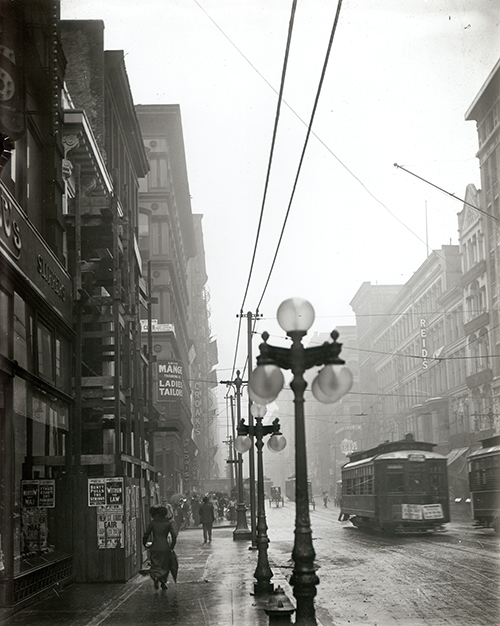
Photographer Unknown
Washington Avenue looking west from Seventh Street
ca. 1900
Photograph
Collection of the Missouri History Museum
Between 1899 and 1901, the area along Washington Avenue beginning with the Eads Bridge was known as the Garment District. Although the area first began to develop around 1870 when plans for the Eads Bridge were finalized, showing that the bridge would terminate there, it was the anticipation for the 1904 World’s Fair that brought about the boom in growth that pushed Saint Louis’ Garment District into competition with New York.
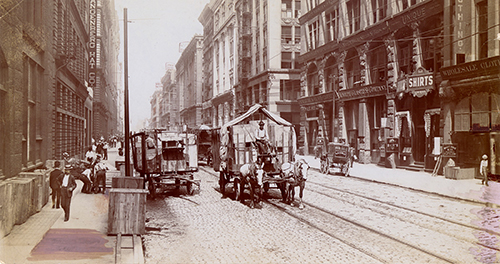
George Stark
Washington Avenue west from Eighth Street
1903
Photograph
Collection of the Missouri History Museum
During this time Washington Avenue was able to claim more shoe manufacturers than any other street in the world, becoming known as “Shoe Street, U.S.A.” While shoes were the focal point of Saint Louis’ industry, other specialty items like hats and juniors clothes were also large parts of the production.
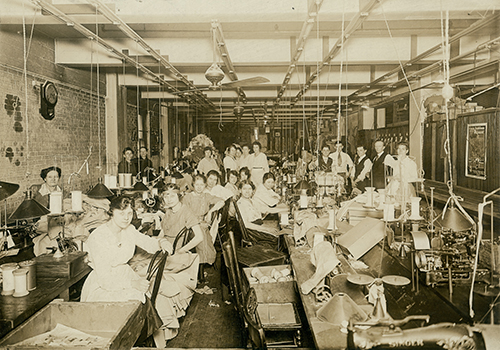
Photographer Unknown
Seamstresses at their stations in the Consolidated Garment Company sewing workshop
February 4, 1919
Photograph
Collection of the Missouri History Museum
For over 30 years the area remained a center of fashion. Unfortunately, the area began to decline in the 1930s with the Great Depression and the invention of new machines that replaced the need for manual labor. Until recently the end of Saint Louis’ Garment District was thought to be marked by the end of the Second World War; however, thanks to the Saint Louis Fashion Fund, the Saint Louis Garment District is being brought back to life.
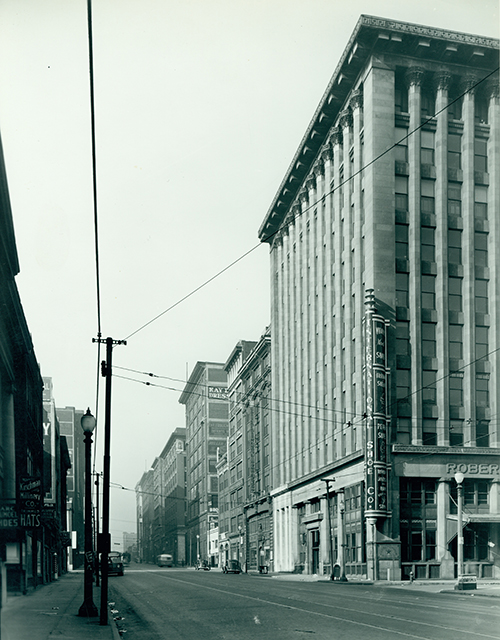
W.C. Persons
Washington Avenue west toward Fifteenth Street
1935
Photograph
Collection of the Missouri History Museum
Saint Louis' Chess History
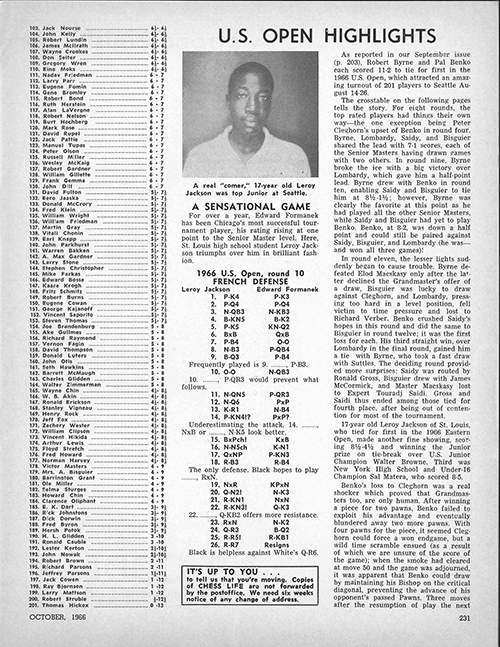
Chess Life Vol. 21, No. 10
October 1966
11 x 8 1⁄4 in.
Periodical
Collection of the World Chess Hall of Fame, gift of John Donaldson
This article highlights the achievements of Leroy Muhammad (born Jackson), a Saint Louis native who gained local and national fame in the late 1960s. Muhammad began playing chess in 1965 while attending Sumner High School and quickly earned recognition for his talent. He was the Missouri Open Champion from 1966 to 1968 and the St. Louis District Champion from 1966 to 1969. He also defeated future U.S. Chess Hall of Fame inductee Walter Browne in 1966, when he became the top junior player in the 1966 U.S. Chess Open. Muhammad largely dropped out of chess following these early victories, though he briefly returned to the game in the 1970s.
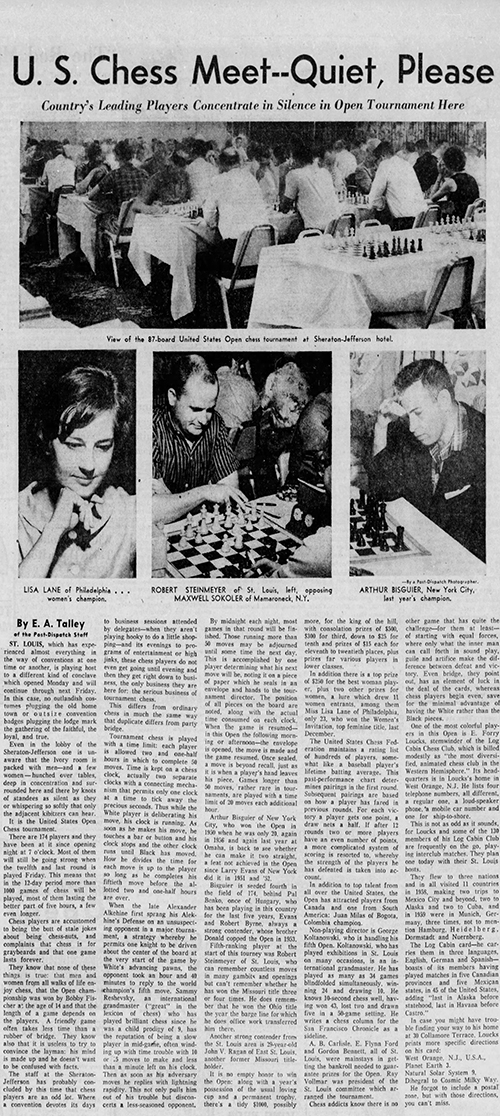
E.A. Talley
“U.S. Chess Meet—Quiet, Please”
St. Louis Post-Dispatch
August 14, 1960
Views of the tournament hall at the Sheraton-Jefferson Hotel (today the Jefferson Arms building) as well as images of national and local chess luminaries top this article, which discusses the 1960 U.S. Open Chess Championship. The competition brought many top American players to the Gateway City, including Pal Benko (U.S. Chess Hall of Fame, 1993), Arthur Bisguier (U.S. Chess Hall of Fame, 1994), Robert Byrne (U.S. Chess Hall of Fame, 1994), Larry Evans (U.S. Chess Hall of Fame, 1994), and Lisa Lane. The article also highlights several local talents, including John Ragan and Robert Steinmeyer, as well as providing information about the rules of the tournament and how it was run. George Koltanowski (U.S. Chess Hall of Fame, 1986), served as tournament director. Byrne and Lane won the open and women’s divisions of the tournament.
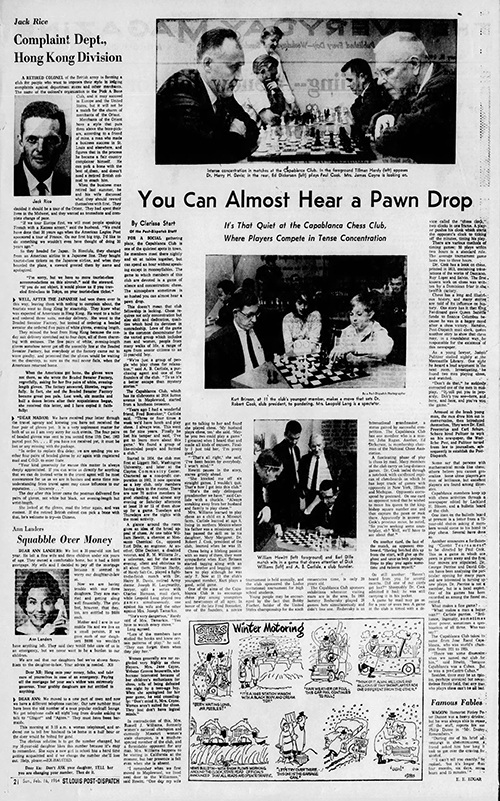
Clarissa Start
“You Can Almost Hear a Pawn Drop”
St. Louis Post-Dispatch
February 16, 1964
“You Can Almost Hear a Pawn Drop” recalls the creation and atmosphere at Saint Louis’ Capablanca Chess Club in the 1960s. Two friends, A.B. Carlisle and Fred Boenecke, founded the club when Boenecke protested that he needed to know more about the game to defeat Carlisle in their friendly games. Created in 1954, Washington University hosted the first location of the club, which later relocated to Clayton, Maplewood, and finally, University City. The writer noted that “Love is the common denominator for the varied group which includes men and women, people from varied walks of life, a range of ages from senior citizens to an 11-year-old boy.” The Club was named after World Chess Champion José Raúl Capablanca (World Chess Hall of Fame, 2001). During the Cold War, naming an American chess club after a Cuban chess player was not without controversy; however, one member noted that the famed player was “a pre-Castro Cuban.”
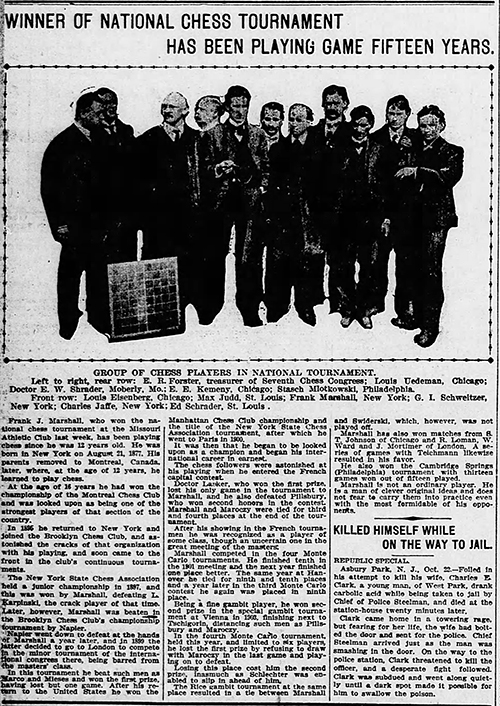
“Winner of National Chess Tournament Has Been Playing Game Fifteen Years”
The St. Louis Republic
October 23, 1904
In Saint Louis, 1904 is most famously known as the year that the city hosted the World’s Fair and the Olympics. However, it was also the year that the city hosted two important chess competitions: the Seventh American Chess Congress and the Western Chess Association Championship. U.S. Chess Champion Frank Marshall (U.S. Chess Hall of Fame, 1986) won the first competition, which also featured local chess luminary Max Judd. Judd was the founder and president of the St. Louis Chess Club. Stasch Mlotkowski took first in the Western Chess Association Championship, a competition now known as the U.S. Open Chess Championship.
Audra Noyes
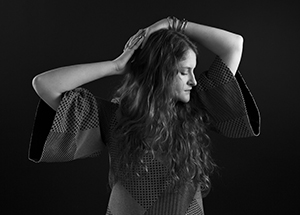
AUDRA is a luxury women’s ready to wear brand that fuses the ease and comfort of American sportswear with the artisan beauty of European luxury. Through refined and unique silhouettes AUDRA strives to redefine the representation of modern women through quality, ethical garments. The garments are exclusively produced in New York City from the finest European fabrics. Noyes received her Bachelor of Fine Arts at the Savannah College of Art and Design in 2010. Upon her graduation, André Leon Talley personally recommended her to train under the direction of Alber Elbaz at LANVIN, where she worked her way up through the design and production departments. In 2012, Noyes joined John Galliano as an Assistant Designer. With a wealth of design experience that included couture pattern-making, draping and illustration, she launched her own brand AUDRA, debuting her collection during the Spring ‘14 Paris Fashion Week.
Noyes is fascinated by the metamorphosis of women and finds inspiration in every aspect of creation. From the hidden treasures in old attics to the human body itself, and the emotional stories within each of us, she translates her experiences into fashion. Each season AUDRA selects a woman with a unique artistic talent whom she feels embodies her collection, including collaborations with poet Cleo Wade, professional dancer Courtney Celeste Spears, and photographer Sophie Elgort. AUDRA advocates for female artists making an impact in their specific field or medium and from season to season wishes to further stretch the boundaries of artistic collaboration within the fashion industry.
AUDRA, which is the colliding of two worlds, paralleled perfectly with the history of the queen piece in the game of chess. Noyes’ avant garde gown represents the power and history of the queen chess piece, which at its foundation is the collision of the rook and the bishop. The two pieces move differently, yet when combined, produce something more powerful that transcends their origins. Noyes mimics the lateral moves of the rook and the diagonal glides of the bishop in the placement of the fabric, embroidery, and in the patterns themselves, harmonizing to create a powerful silhouette emphasizing the fusion of two worlds. Noyes solidified a partnership with Swarovski, utilizing their crystals to trace the movements of the rook and bishop, as well as further speak to the uniqueness of the beauty of the queen.
Challenged by the idea of “branding” the game of chess, Noyes focused on celebrating the legacy and class of chess, whilst fusing the functional needs of the modern player in her second look. The Shawl Collar Jacket combines the tailored jacket and vest into one garment, and incorporates design elements and fabric placements that are specific for chess players’ comfort and needs during competition. For example, a three-quarter length sleeve that eliminates hindrance during play and a logo-ready back collar allowing for team or sponsor branding. In her designs of the uniform jacket, which emphasizes ease of wear, Noyes envisions creating a complete capsule for both male and female, building brand recognition for the game of chess from grandmaster to mass market.
AUDRA Brand Video, 2016
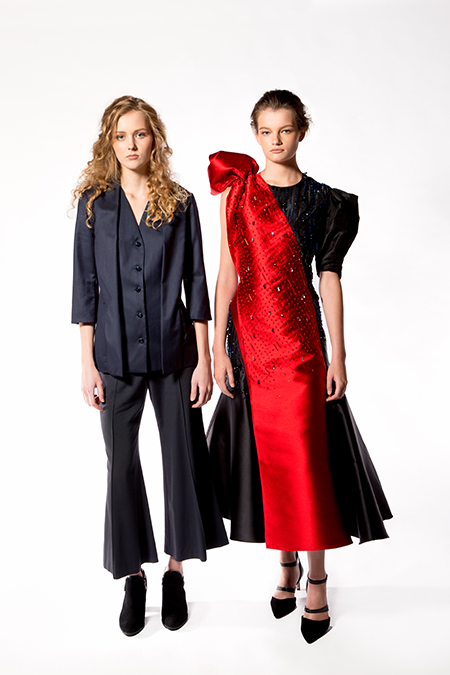
AUDRA
Saint Louis, Missouri
Shawl Collar Blazer and Cropped Flare Pant, 2017 (left)
Wool, cashmere, and wick ‘n dry polyester
Swarovski Hand-Embellished Asymmetrical Bias Gown, 2017 (right)
Silk cotton mikado, silk taffeta, and Swarovski crystals
Collection of Audra Noyes
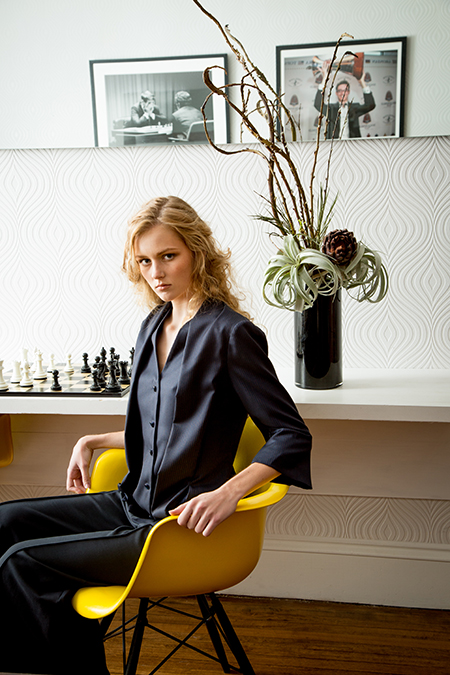
AUDRA
Saint Louis, Missouri
Shawl Collar Blazer and Cropped Flare Pant, 2017
Wool, cashmere, and wick ‘n dry polyester
Collection of Audra Noyes
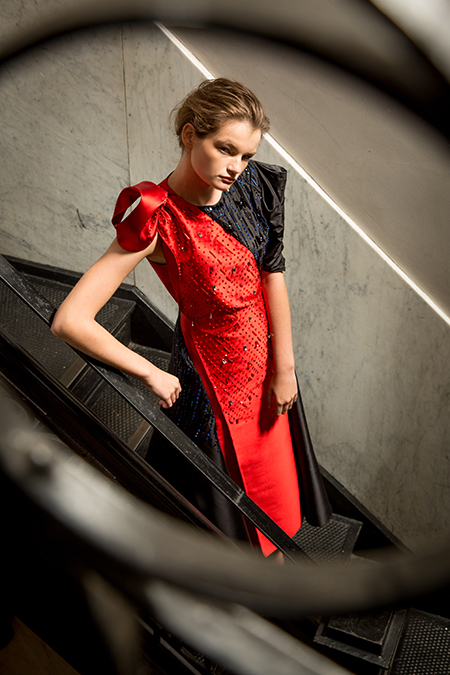
AUDRA
Saint Louis, Missouri
Swarovski Hand-Embellished Asymmetrical Bias Gown, 2017
Silk cotton mikado, silk taffeta, and Swarovski crystals
Collection of Audra Noyes
Charles Smith II

Originally from Harlem, New York, and now residing in Dallas, Texas, Charles Smith II is an up and coming young designer who is leading young members of the art and fashion communities both in his own community and on an international stage. His diverse aesthetic vision is apparent in both his luxury brand Smith II and his edgier ready-to-wear brand S2 by Smith II.
Transitioning from being a player in the NBA D-League, to a model, and finally to a designer showed him just how powerful following your dreams can be. He has walked in Mercedes-Benz Fashion Week in New York as well as in Miami, Berlin, London, Paris, and Milan, experiences through which he saw one side of the industry. While living in Milan, Italy, from ages 14 to 16 and again from 19 to 21, Smith honed a European style through firsthand experience in the European fashion world. Smith inspires and influences his young followers by showing them that a kid from Harlem can make any dream come true.
Both the idea of chess as a game of war and the traditional black and white colors associated with the game influenced Smith’s chess challenge designs. With a goal to create intimidating figures through these pieces, he added black stripes to the garments, referencing symbols of rank on a military uniform. This idea of intimidation was inspired by the psychological gameplay that some famous chess players have been known to demonstrate. Smith believes these pieces are fashion forward, yet wearable, and represent the hipper perception of chess as it becomes more and more popular.
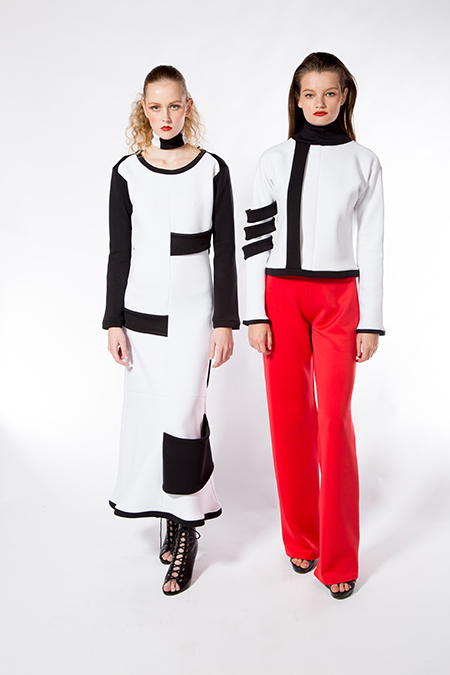
Smith II
Dallas, Texas
Long-Sleeve Black and White Dress with Choker, 2017 (left)
Athletic Poly Neoprene
White and Black Jacket with Sleeve Bands and Red Pants, 2017 (right)
Athletic Poly Neoprene
Collection of Charles Smith II
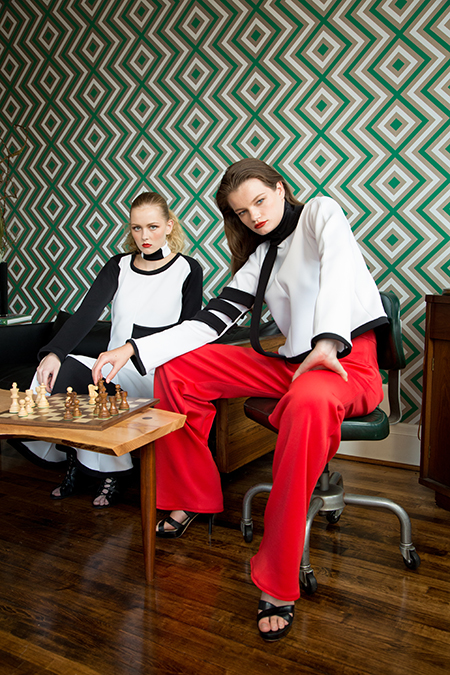
Smith II
Dallas, Texas
Long-Sleeve Black and White Dress with Choker, 2017 (left)
Athletic Poly Neoprene
White and Black Jacket with Sleeve Bands and Red Pants, 2017 (right)
Athletic Poly Neoprene
Collection of Charles Smith II
Agnes Hamerlik

Polish-born designer Agnes Hamerlik’s luxury label produces timeless nouveau-couture collections. She is an interdisciplinary artist whose Master’s Degree in European Literature, BFA in Fashion Studies from Columbia College, and apprenticeships with master craftsmen inform her work. Inspired by various forms in nature, she creates dramatic silhouettes through complex pattern making and unique surface engineering. Her garments exemplify a harmony among body, material, and identity. Hamerlik uses the principles of the traditional couturier while also maintaining a spirit of experimentation, conceptuality, innovation, and exploration of unisex through the knowledge of humanity. Opposed to mainstream fashion and beauty norms, the Agnes Hamerlik brand ethos is to be forward thinking. The Japanese concept of wabi-sabi, which focuses on the acceptance of transience and the art of imperfection, inspires the collections. Shakespeare said “the clothes make the man,” and Hamerlik believes “the wearer completes the garment.”
Hamerlik sees similarities between designing and creating and playing chess. Both involve calculation, reflection, strategy, and risk in order to be successful. The simplicity of the light and dark design of the chessboard inspired her work. Its pattern evokes many dualities found in nature: good and evil, victory and defeat, and the visible and hidden.
The first, more editorial look, interprets chess in a pure form. The floor-length asymmetrical gown with strong draping lines refers to the manipulation of the chessboard and paths of the pieces. It is powerful and regal, emulating the queen piece. Similar to a player selecting moves, Hamerlik pinned and basted each piece together, ensuring that each seam and stitch was a perfect part of the final garment. The surface embellishments, made from recycled and reworked fabrics from the design process, reflect the mental components of playing chess. Pleated raw materials create armor with subtle patterns and textures, referring to chess’ identity as a game of battle. An empowering garment might provide the wearer with the armor needed to overcome their struggles. Recycled materials allude to being resourceful in challenging situations, while smaller details evoke cunning and intelligence.
The second look is more commercial, created for an elegant, dignified, and resourceful chess player. Like the chess queen, she is passionate and powerful. The voluminous silhouette represents her aura of mystery and propensity for unexpected stratagem. Constructed from durable and comfortable materials—cotton and silk—the garment can sustain long periods of wear and remain beautiful. A reference to a player’s adaptability, it can be belted or tied, resulting in a different look depending on the wearer’s mood. Like the tactics hidden up her sleeve, the dress contains concealed features, such as an inseam pocket tucked into asymmetrical pleats. These encourage the wearer to establish emotional ties to their wardrobe and gain secret confidence. Durable french seams and a lining to protect them are perhaps the most critical components. Like the preliminary moves in a chess game, these components secure the garment’s strength and quality. A true fusion between beauty and intelligence, each garment is a reflection of thought, talent, and execution.
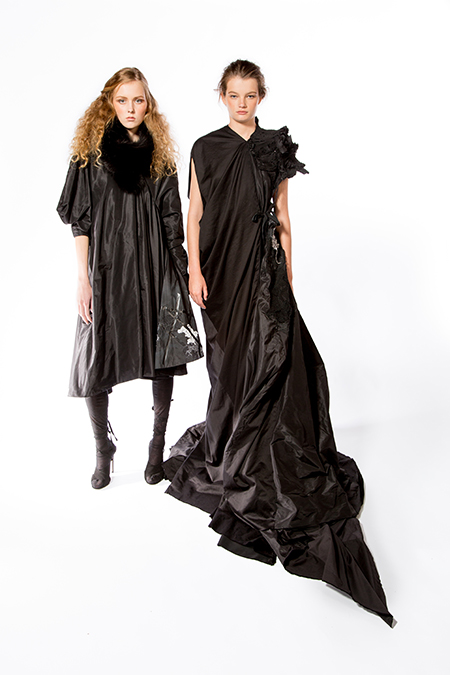
Agnes Hamerlik
Chicago, Illinois
Asymmetrically Draped Voluminous Dress with Strong Draping Lines, 2017 (left)
Silk taffeta and lace
Floor Length Asymmetrical Gown, 2017 (right)
Silk taffeta, lightweight cotton/silk, and heavyweight cotton/silk
Collection of Agnes Hamerlik
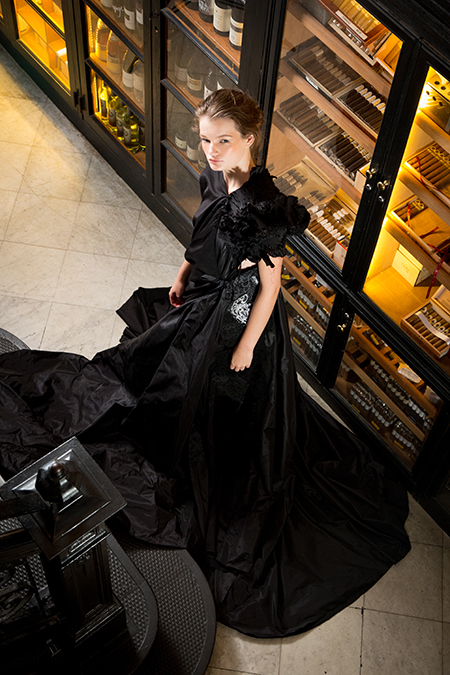
Agnes Hamerlik
Chicago, Illinois
Floor Length Asymmetrical Gown, 2017
Silk taffeta, lightweight cotton/silk, and heavyweight cotton/silk
Collection of Agnes Hamerlik
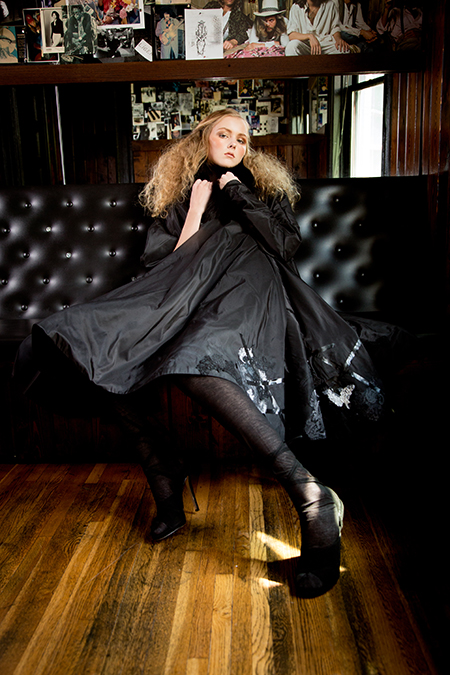
Agnes Hamerlik
Chicago, Illinois
Asymmetrically Draped Voluminous Dress with Strong Draping Lines, 2017
Silk taffeta and lace
Collection of Agnes Hamerlik
Allison Mitchell

ALLISON MITCHELL is an emerging luxury handbag label dedicated to designing and producing pieces made from exotic textiles, hides, and skins. The minimalist brand offers a polished, deconstructed look that makes a statement with unique shapes in unexpected, exceptional materials and colors. The designer creates bags for women that strive to set the design pace and aesthetic rather than following it. Mitchell’s handbags and accessories are wearable pieces of art made for the already-empowered woman who expresses herself freely and thoughtfully.
As the founder of a digital marketing agency in Dallas, Texas, designer Allison Mitchell did not intend to pursue a career in the fashion industry. It was Mitchell’s desire for a minimalist, oversized clutch that led her to crafting her own, and soon, demand went beyond friends and family to a buyer from a local luxury boutique. Mitchell launched her namesake label and never looked back.
All bags are manufactured and finished by hand in New York City. Mitchell personally sources all of the skins and hides from around the world; she only works with tanneries that practice sustainability and conform to regulations. As a final touch and an unexpected surprise for the customer, Mitchell selects vibrant, thoughtful linings to highlight her specialized materials. The linings include vintage Japanese kimonos, chartreuse velvet, and soft Italian leathers.
Allison Mitchell’s pieces for the PINNED! design competition were inspired by tortoiseshell chess sets featured in Animal, Vegetable, Mineral: Natural Splendors from the Chess Collection of Dr. George and Vivian Dean (September 29, 2016 – March 12, 2017), a past exhibition at the World Chess Hall of Fame. The exhibition presented extraordinary chess sets along with the materials and tools used to create them. Two tortoiseshell chess sets were displayed alongside two examples of tortoise shells on loan from The Field Museum of Natural History. One featured pieces modeled on silhouettes while another had pieces that were sculptural busts created from layers of tortoiseshell.
In keeping with the competition’s requirements, the artisan handbag is Mitchell’s interpretation of the chess set that inspired her pieces, and the second is a scaled back version of the first, meant to be ready for mass-market consumption. The artisan handbag features a sustainably obtained turtle shell with hand-application gold leaf down the center panel for decorative effect. The second piece is a sculptural imitation of the turtle shell shape, made entirely of black leather with a decorative panel of embossed calf hair sewn down the center.
Creating an accessory truly sets Mitchell’s competition pieces apart from the other designers. Because chess players are not allowed to bring bags into a tournament, Mitchell moved away from designing a functional bag specifically for chess players and instead found creative inspiration from the visual elements of the game to produce her two pieces.
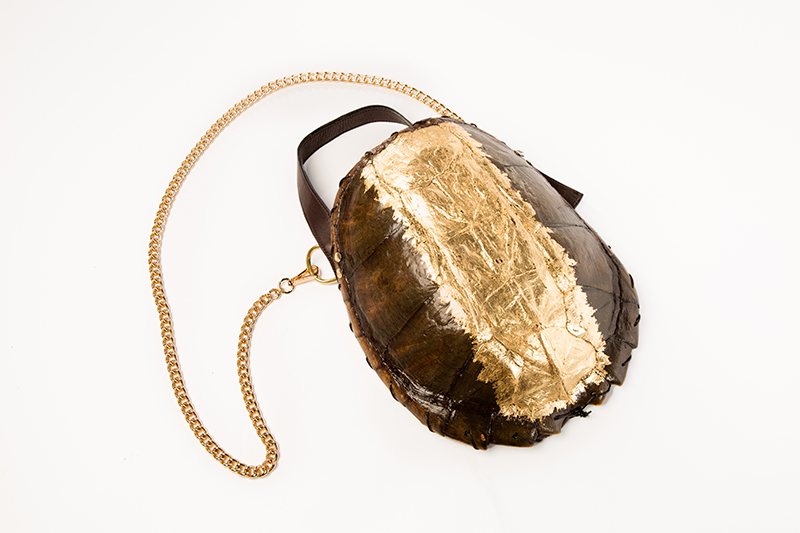
ALLISON MITCHELL
Dallas, Texas
Turtle Shell Crossbody, 2017
Snapping turtle shell, gold leaf, leather, gold hardware, and suede
Collection of Susan Block
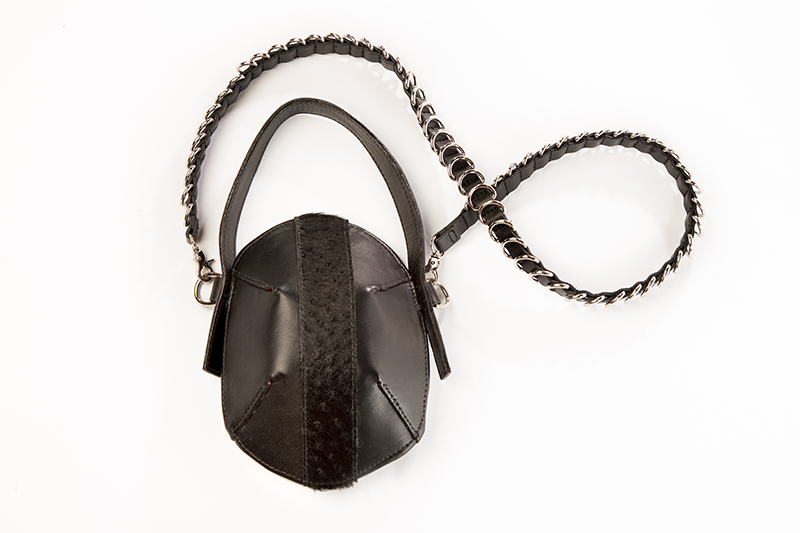
ALLISON MITCHELL
Dallas, Texas
Sculptural Mini Crossbody, 2017
Leather, embossed calf hair, silver hardware, and suede
Collection of Eliot Tao
Emily Brady Koplar
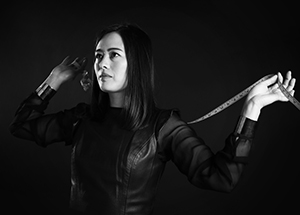
Wai Ming launched in high-end specialty boutiques in 2012 and has continued to define its place in the contemporary design space with its clean, feminine-yet-graphic aesthetic, intricate design details, and thoughtfully versatile designs. The line is designed for and inspired by strong, dynamic, global women who appreciate the beauty and ease of Wai Ming’s effortlessly polished aesthetic. Each piece from the collection is carefully crafted in the best factories of New York’s Garment District using luxurious fabrics from Italy and Japan.
Wai Ming, which means “gift of light” in Chinese, is the given middle name of founder and designer, Emily Brady Koplar. Koplar, who divides her time between Saint Louis and New York, has worked in the fashion industry for more than a decade but started designing and making clothes in her early childhood. She obtained a degree in Economics from Boston University before deciding to follow her true passion of fashion design and earning a degree from Parsons School of Design.
Koplar’s competition pieces were inspired by the chessboard, as seen through the layout of the intricate panels. The stretch fabric allows for extra ease for the players giving them comfort and extra movement during their matches. The avant-garde dress was inspired by the strength of the queen chess piece and the ability of the queen to roam freely in battle. The laser-cut outline details of the neck and belt, give an almost armour-like illusion, yet maintain the wearer’s femininity. The collection blends a tough, strong queen with a delicate femininity.
The architecturally-inspired chess collection celebrates the history and beauty of the game while creating a take on the traditional blazer that could be part of an official uniform and is also versatile enough to attract a wider audience.

Wai Ming
Saint Louis, Missouri
Pinstripe Jacket with Pants, 2017 (left)
Japanese jersey, quilted crepe, and Italian crepe
Bustier with ‘Rook’ Belt and Pleated Skirt, 2017 (right)
Quilted crepe, leather, silk, and georgette
Collection of Emily Brady Koplar

Wai Ming
Saint Louis, Missouri
Pinstripe Jacket with Pants, 2017 (left)
Japanese jersey, quilted crepe, and Italian crepe
Bustier with ‘Rook’ Belt and Pleated Skirt, 2017 (right)
Quilted crepe, leather, silk, and georgette
Collection of Emily Brady Koplar
Reuben Reuel

Reuben Reuel is the creative director and designer of Demestik by Reuben Reuel.
In 2012, Reuel decided to venture out on his own and create garments with a focused aesthetic. Demestik by Reuben Reuel is sold direct to customer worldwide through online distribution channels.
Reuel’s competition pieces were inspired by the knight and the pawn—two of the weakest pieces on the chessboard. By combining them in fashion, Reuben sought to strengthen them. The shape and structure of the dress mimics the shape of a traditional pawn and knight elements decorate the sleeve.
Reul specifically chose the strong black and white prints that married with his brand Demestik and referenced the game through their geometric or chessboard patterns. Reuel’s take on the game is that chess is sexy; therefore, he created a silhouette that looked like a woman’s body to round out his fun, chic, and very feminine collection.
Inside the Studio with Reuben Reuel
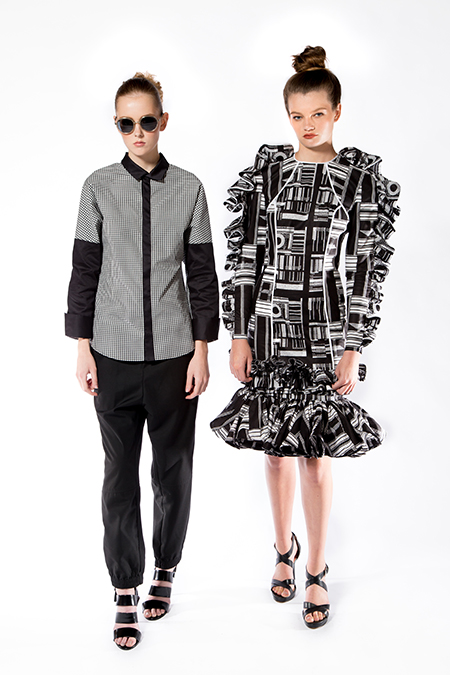
Demestik by Reuben Reuel
Saint Louis, Missouri
Black and White Gingham Shirt, 2017 (left)
Cotton
Black and White Printed Dress, 2017 (right)
Dutch wax cotton
Collection of Reuben Reuel
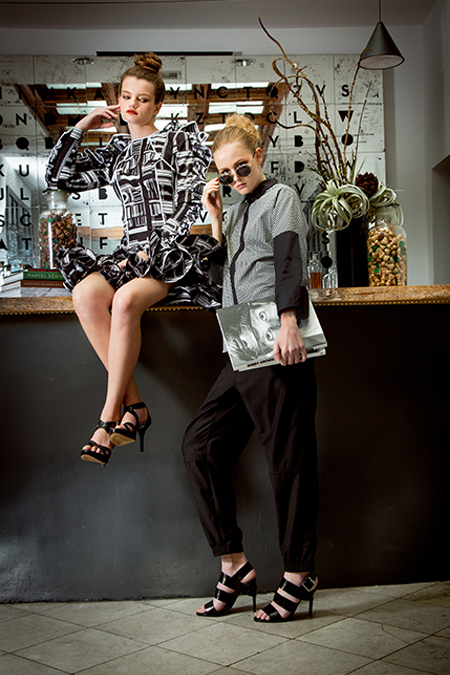
Demestik by Reuben Reuel
Saint Louis, Missouri
Black and White Printed Dress, 2017 (left)
Dutch wax cotton
Black and White Gingham Shirt, 2017 (right)
Cotton
Collection of Reuben Reuel
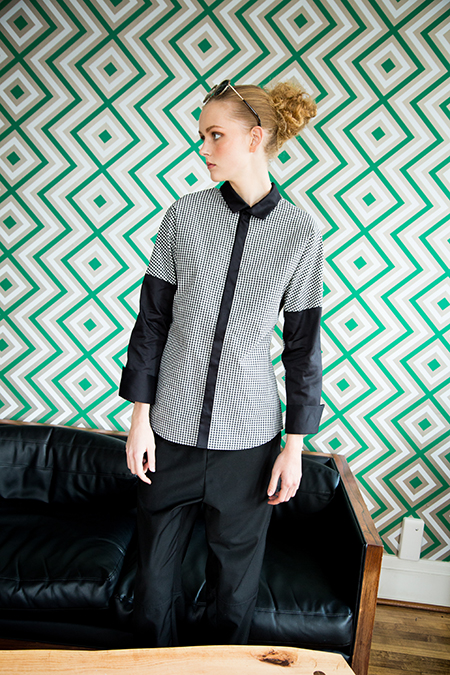
Demestik by Reuben Reuel
Saint Louis, Missouri
Black and White Gingham Shirt, 2017
Cotton
Collection of Reuben Reuel
Designer Photography by Geoff Story, TOKY
Grandmaster Photography by Austin Fuller, Matt Kile, and Spectrum Studios
Location photography by Carmody Creative, shot at The BHIVE at Brennan's
Installation photography by Austin Fuller

Sinquefield Cup Opening Ceremony & "PINNED! A Designer Chess Challenge" Unveiling - SOLD OUT
Tuesday, August 1 6pm
Read More

2017 Fall Exhibitions Opening Reception
Friday, October 6 6pm
Read More

Crafts & Cocktails: Faux Tie-Dye
Wednesday, October 11 6pm
Read More

Crafts & Cocktails: Learn to Embroider with Perennial
Wednesday, November 1 6pm
Read More

Sip, Sketch & Socialize: Drawing with Juan William Chávez
Wednesday, November 8 6pm
Read More


